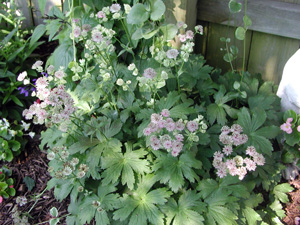Resource Library
Plant of the Week: Masterwort
The University of Arkansas System Division of Agriculture does not promote, support or recommend plants featured in "Plant of the Week." Please consult your local Extension office for plants suitable for your region.
Plant of the Week
Masterwort
Latin: Astrantia major

Like all gardeners, I have varying degrees of experience with plants. I try to write about a plant only after I’m familiar enough with it to express a personal opinion regarding its attributes. But sometimes, as is the case here, I will give what can only be considered a preliminary report on a plant that has been gaining prominence in American garden catalogs: Astrantia major, Masterwort.
Masterwort, a common name shared by at least two members of the carrot family, is a clump-forming or slowly stoloniferous perennial herb growing 2 to 3 feet tall when in flower, but only half that when in leaf. Leaves are rich green with a palmate arrangement and five prominent lobes, each of which is cut or incised terminally. The plants I planted in the fall or 2010 were not evergreen.
Flowers emerge in late spring on upright, branched panicles and appear sporadically through the summer. The flowers are technically an umbel but very different than Queen Anne’s lace and other members of the parsley family, because in Astrantia each bloom is subtended by a broad, papery bract giving the bloom head an almost daisy-like look. Flower heads are 1 to 1 ½ inch wide and produced in considerable numbers. Bloom color of the species is white, but in most of the clones now being marketed the flowers are pink, maroon or red.
Astrantia is a genus of 10 species of southern and central Europe, where it is found in high mountain meadows and in alpine woodlands in the Alps, where the roots are kept well watered by melting snow. Astrantia major is native to Switzerland and Austria, and was introduced into cultivation before 1600. It is the only commonly grown species. Masterwort has been commonly grown in European gardens, waxing and waning in popularity over the decades, but was mostly unknown in the United States until Dutch breeders began developing new selections in the 1990s. Many of these were intended for the cut flower market but have proven suitable for the perennial border too.
‘Roma’, a vigorous, easily grown pink selection from Holland, seems to be the most common masterwort in the trade. It is a patented plant (PP 11,470; 2000) that has been picked up and marketed as one of the Darwin Plants out of the Netherlands.
Masterworts are best when given moist-to-wet, but well-drained conditions in partial shade. They grow best in a rich, organic woodland soil with an average pH. Though rated as hardy from zones 4 through 7, they will likely suffer in areas with high summer nighttime temperatures. The plants I planted a year ago came through the winter fine and bloomed well in late May and June. So far the deer seem to be leaving them alone, after a few chomps to try them out.
The fate of masterwort in Arkansas gardens is uncertain at this writing. So far, my year-old planting looks good and vigorous, but it is in a well-irrigated and shaded site. If the plant is to survive long term, it will probably need to send out new stolons and spread about a bit, because oftentimes flowering stems of members of the carrot family die after flowering.
The flowers of masterwort are good for fresh or dried arrangements. They are grown commercially as cut flowers, making a good, long-lasting bloom because the papery bracts persist longer than the petals of many blossoms. They are recommended for use as a streamside planting (where I have used them), or as an informal groundcover in open woodlands or in the mixed perennial border.
By: Gerald Klingaman, retired
Retired Extension Horticulturist - Ornamentals
Extension News - July 8, 2011
The University of Arkansas System Division of Agriculture does not maintain lists of retail outlets where these plants can be purchased. Please check your local nursery or other retail outlets to ask about the availability of these plants for your growing area.